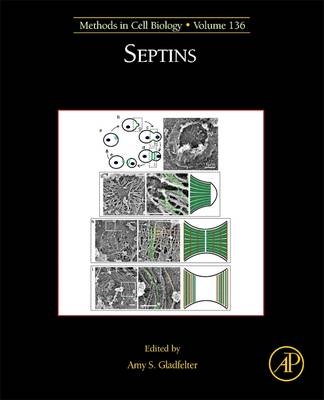
Septins
Academic Press Inc (Verlag)
978-0-12-803998-4 (ISBN)
Dr. Gladfelter studied Molecular Biology at Princeton University, spending her freshman year researching electrophysiology on mammalian tissue with Dr. Simon Lewis at UTMB-Galveston, followed by genetics with Toby Bradshaw at University of Washington. Dr Gladfelter worked at Princeton in Bonnie Bassler’s lab studying bioluminescence in marine bacteria in the early days of quorum sensing. She then went on to graduate school at Duke University, drawn back toward the strong microbial and fungal genetics program. Here she began working with budding yeast S. cerevisiae in Danny Lew’s lab. Her thesis work focused on understanding how cells polarize and began with a focus on Cdc42 signaling. By analyzing a variety of Cdc42 mutants, she found a subset with defects in assembly of septin proteins. This began an interest in this understudied aspect of the cytoskeleton that continues to this day in her own lab and is the theme of this volume. With the encouragement of a few key mentors, she went abroad to do a post-doc in Basel, Switzerland at the Biozentrum to work in the lab of Peter Philippsen. Peter had just tamed a new model system-a filamentous fungus-called Ashbya that provided many wide open questions and intriguing cell biology. Here, she began studying the problem of how nuclei sharing a common cytoplasm can divide autonomously, a problem that seeded the projects in her independent group at Dartmouth. Dr Gladfelter began her lab at Dartmouth in 2006, focusing on understanding how cytosol is compartmentalized and revisited her old passion for the septin cytoskeleton. Much of the work in the lab takes advantage of different fungal model systems-including budding and fission yeast, Neurospora crassa as well as Ashbya. Recently the lab has begun work on several mammalian multinucleated cells including muscle. She has varied collaborations with modelers, biophysicists and microscopy developers. In particular, her work has been especially enriched by collaborations during the summer at the Marine Biological lab in Woods Hole, MA. In 2015, she was awarded the American Society of Cell Biology WICB mid-career award for research.
1. The Non-Opisthokont Septins: How Many There Are, How Little We Know About Them, and How We Might Learn MoreMasayuki Onishi and John R. Pringle2. Preparing Recombinant Yeast Septins and Their Analysis by Electron MicroscopyAurélie Bertin and Eva Nogales3. A FRET-Based Method for Monitoring Septin Polymerization and Binding of Septin-Associated ProteinsElizabeth A. Booth and Jeremy Thorner4. In Vitro Reconstitution of Septin Assemblies on Supported Lipid BilayersAndrew A. Bridges and Amy S. Gladfelter5. Visualization of In Vivo Septin Ultrastructures by Platinum Replica Electron MicroscopyKaty Ong, Tatyana Svitkina and Erfei Bi6. Assays for Genetic Dissection of Septin Filament Assembly in Yeast, From De Novo Folding Through PolymerizationMichael A. McMurray7. Investigation of Septins Using Infection by Bacterial PathogensSina Krokowski and Serge Mostowy8. In Vivo Analysis of Septin Heteropolymer Rods and Higher-Order Structures in Filamentous FungiAmy Smith and Michelle Momany9. Live Cell Imaging of Septin Dynamics in Ustilago maydisSebastian Baumann, Sabrina Zander, Stefanie Weidtkamp-Peters and Michael Feldbrügge10. Ashbya gossypii as a Model System to Study Septin Organization by Single-Molecule Localization MicroscopyCharlotte Kaplan, Chenlu Yu and Helge Ewers11. Visualizing Septins in Early Drosophila EmbryosManos Mavrakis12. Purification of Recombinant Human and Drosophila Septin Hexamers for TIRF Assays of Actin-Septin Filament AssemblyManos Mavrakis, Feng-Ching Tsai and Gijsje H. Koenderink13. Investigation of Septin Biology In Vivo Using ZebrafishAlexandra Willis, Maria Mazon Moya and Serge Mostowy14. Fluorescence Microscopy of Actin- and Microtubule-Associated Septins in Mammalian CellsElias T. Spiliotis, Eva P. Karasmanis and Lee Dolat15. Immunofluorescent Staining of Septins in Primary CiliaMoshe S. Kim, Carol D. Froese, Hong Xie and William S. Trimble16. Methods for Immunoblot Detection and High-Resolution Subcellular Mapping of Septin Subunits in Mammalian Nervous SystemsLaxmi Kumar Parajuli, Natsumi Ageta-Ishihara, Hiroshi Ageta, Yugo Fukazawa and Makoto Kinoshita17. Visualizing Septin and Cell Dynamics in Mammalian Brain SlicesHidenori Ito, Rika Morishita, Hidenori Tabata and Koh-ichi Nagata18. Small Molecule Perturbations of SeptinsLydia R. Heasley and Michael A. McMurray19. Septin Crystallization for Structural AnalysisNapoleão Fonseca Valadares and Richard Charles Garratt
| Erscheinungsdatum | 13.08.2016 |
|---|---|
| Reihe/Serie | Methods in Cell Biology |
| Verlagsort | San Diego |
| Sprache | englisch |
| Maße | 191 x 235 mm |
| Gewicht | 970 g |
| Themenwelt | Naturwissenschaften ► Biologie ► Biochemie |
| Naturwissenschaften ► Biologie ► Zellbiologie | |
| ISBN-10 | 0-12-803998-1 / 0128039981 |
| ISBN-13 | 978-0-12-803998-4 / 9780128039984 |
| Zustand | Neuware |
| Haben Sie eine Frage zum Produkt? |
aus dem Bereich


